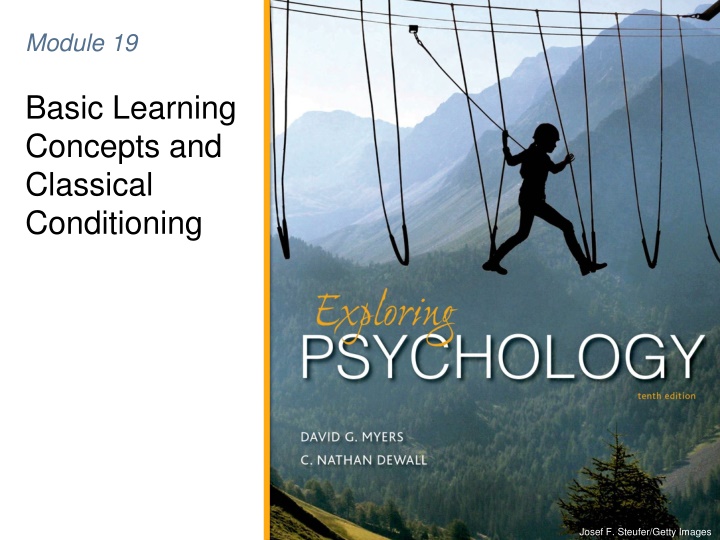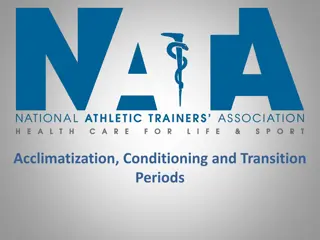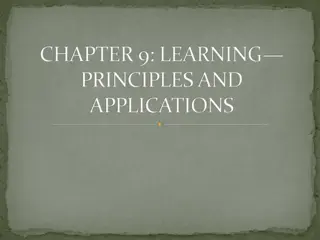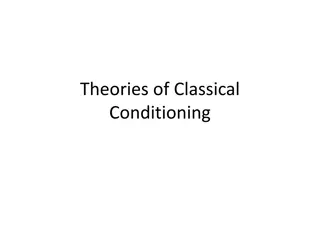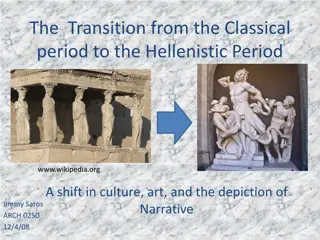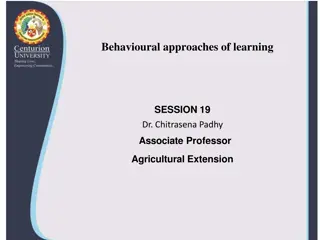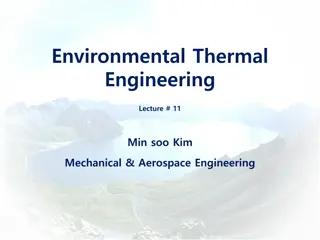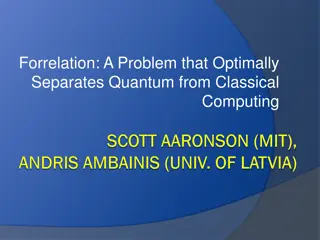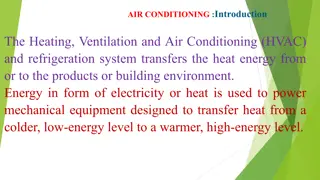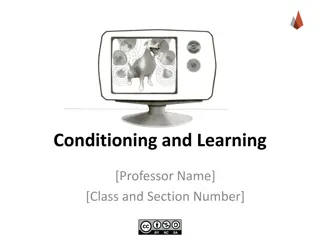Basic Learning Concepts and Classical Conditioning
Acquiring new information and behaviors through experience is known as learning. One common way we learn is through associative learning, where we connect certain events together. This process can take the form of classical conditioning, where stimuli evoke automatic responses, or operant conditioning, where behaviors are associated with consequences. Cognitive learning is another form, involving the acquisition of mental information through observation or language. The famous experiments of Ivan Pavlov highlight classical conditioning and the link between stimuli and anticipated events in learning.
Download Presentation

Please find below an Image/Link to download the presentation.
The content on the website is provided AS IS for your information and personal use only. It may not be sold, licensed, or shared on other websites without obtaining consent from the author.If you encounter any issues during the download, it is possible that the publisher has removed the file from their server.
You are allowed to download the files provided on this website for personal or commercial use, subject to the condition that they are used lawfully. All files are the property of their respective owners.
The content on the website is provided AS IS for your information and personal use only. It may not be sold, licensed, or shared on other websites without obtaining consent from the author.
E N D
Presentation Transcript
Module 19 Basic Learning Concepts and Classical Conditioning Josef F. Steufer/Getty Images
Basic Learning Concepts and Classical Conditioning How Do We Learn? 19-1: WHAT IS LEARNING, AND WHAT ARE SOME BASIC FORMS OF LEARNING? Learning: Process of acquiring through experience new and relatively enduring information or behaviors One way we learn is by association. Associative learning : Learning that certain events occur together. The events may be two stimuli (as in classical conditioning) or a response and its consequences (as in operant conditioning).
Basic Learning Concepts and Classical Conditioning How Do We Learn? A stimulus is an event or situation that evokes a response. The process of learning associations is conditioning, which takes two main forms: In classical conditioning, we associate stimuli that we do not control, and we automatically respond (exhibiting respondent behaviors). In operant conditioning, we associate a response (our behavior) and its consequence (producing operant behaviors). Conditioning, this process of learning associations, is not the only form of learning: cognitive learning is another. Cognitive learning: The acquisition of mental information, whether by observing events, by watching others, or through language. Observational learning is one form of cognitive learning. It lets us learn from others experiences.
Basic Learning Concepts and Classical Conditioning Classical Conditioning 19-2: WHAT WAS BEHAVIORISM S VIEW OF LEARNING? Ivan Pavlov s early twentieth-century experiments are psychology s most famous research. Classical conditioning: Type of learning in which one learns to link two or more stimuli and anticipate events. Behaviorism Psychology (1) should be an objective science that (2) studies behavior without reference to mental processes. Most research psychologists today agree with (1) but not with (2).
Basic Learning Concepts and Classical Conditioning Classical Conditioning: Pavlov s Experiments 19-3: WHO WAS PAVLOV, AND WHAT ARE THE BASIC COMPONENTS OF CLASSICAL CONDITIONING? Pavlov Studied the digestive system; first Russian Nobel Prize (1904 ) Demonstrated associative learning via salivary conditioning
Basic Learning Concepts and Classical Conditioning Classical Conditioning: Pavlov s Experiments Neutral stimulus (NS): In classical conditioning, a stimulus that elicits no response before conditioning Unconditioned response (UR): In classical conditioning, an unlearned, naturally occurring response (such as salivation) to an unconditioned stimulus (US) (such as food in the mouth) Unconditioned stimulus (US): In classical conditioning, a stimulus that unconditionally naturally and automatically triggers an unconditioned response (UR)
Basic Learning Concepts and Classical Conditioning Classical Conditioning: Pavlov s Experiments Conditioned response (CR): In classical conditioning, a learned response to a previously neutral (but now conditioned) stimulus (CS) Conditioned stimulus (CS): In classical conditioning, an originally irrelevant stimulus, that, after association with an unconditioned stimulus (US), comes to trigger a conditioned response (CR) For three decades, Pavlov s research demonstrated associative learning, exploring five major conditioning processes (acquisition, extinction, spontaneous recovery, generalization, and discrimination)
Basic Learning Concepts and Classical Conditioning Classical Conditioning 19-4: IN CLASSICAL CONDITIONING, WHAT ARE THE PROCESSES OF ACQUISITION, EXTINCTION, SPONTANEOUS RECOVERY, GENERALIZATION, AND DISCRIMINATION? Initial stage, when one links a neutral stimulus and an unconditioned stimulus so that the neutral stimulus begins triggering the conditioned response Acquisition Diminishing of a conditioned response; occurs in classical conditioning when an unconditioned stimulus (US) does not follow a conditioned stimulus (CS) Extinction Reappearance, after a pause, of an extinguished conditioned response Spontaneous recovery
Idealized Curve of Acquisition, Extinction, and Spontaneous Recovery
Basic Learning Concepts and Classical Conditioning Classical Conditioning: Acquisition Generalization Tendency, once a response has been conditioned, for stimuli similar to the conditioned stimulus to elicit similar responses Discrimination Learned ability to distinguish between a conditioned stimulus (which predicts the US) and other irrelevant stimuli
Generalization Pavlov demonstrated generalization by attaching miniature vibrators to various parts of a dog s body. After conditioning salivation to stimulation of the thigh, he stimulated other areas. The closer a stimulated spot was to the dog s thigh, the stronger the conditioned response. (From Pavlov, 1927.)
Basic Learning Concepts and Classical Conditioning Classical Conditioning: Pavlov s Legacy 19-5: WHY DOES PAVLOV S WORK REMAIN SO IMPORTANT? Consensus among psychologists that classical conditioning is a basic form of learning. Why should we care that dogs can be conditioned to the sound of a tone? Many other responses to many other stimuli can be classically conditioned in many other organisms. Pavlov demonstrated how a learning process can be studied objectively. Classical conditioning is a basic form of learning that applies to all species.
Basic Learning Concepts and Classical Conditioning Classical Conditioning: Applications of Classical Conditioning 19-6: WHAT HAVE BEEN SOME APPLICATIONS OF PAVLOV S WORK TO HUMAN HEALTH AND WELL-BEING? HOW DID WATSON APPLY PAVLOV S PRINCIPLES TO LEARNED FEARS? Pavlov s principles are used to influence human health and well-being Areas of consciousness, motivation, emotion, health, psychological disorders, therapy Addicts counseled to avoid stimuli (for example, people and settings) that may trigger cravings Pairing particular taste with drug that influences immune responses may eventually lead to immune response from taste alone
Basic Learning Concepts and Classical Conditioning Classical Conditioning: Applications of Classical Conditioning Pavlov s work also provided a basis for Watson s ideas that human emotions and behaviors, though biologically influenced, are mainly a bundle of conditioned responses. Watson applied classical conditioning principles in his studies of Little Albert to demonstrate how specific fears might be conditioned. Watson boasted that he could take any healthy infant and train for any career specialization, regardless of any inborn traits, but later admitted to going beyond his facts.
